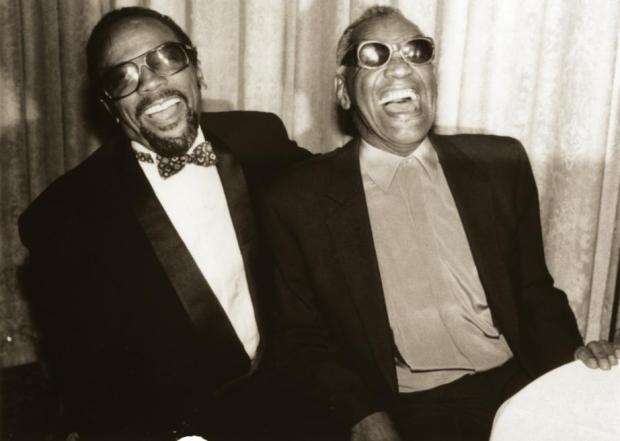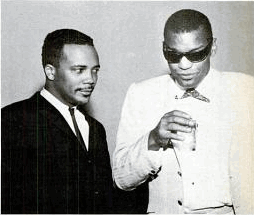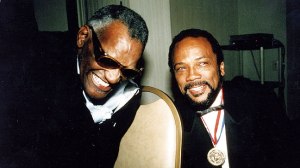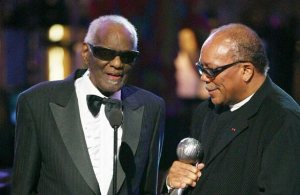This Just In From Seattle Music History!!!

HISTORY LESSON: THE SEATTLE MUSIC SCENE – RAY CHARLES AND QUINCY JONES
When I think about Seattle, Washington, I think about three things. First, Seattle Grace Hospital, the setting for Grey’s Anatomy, second the Seattle Seahawks home of Marshawn Lynch and third never ending rain. I had no idea that even before Grey’s and Marshawn Seattle, in the 1940s, was home to a vibrant culture of Jazz and a new genre now known as R&B (then called “race records”). It was a Northwest Renaissance of sorts much like the one in Harlem in the 1920s.
about Seattle, Washington, I think about three things. First, Seattle Grace Hospital, the setting for Grey’s Anatomy, second the Seattle Seahawks home of Marshawn Lynch and third never ending rain. I had no idea that even before Grey’s and Marshawn Seattle, in the 1940s, was home to a vibrant culture of Jazz and a new genre now known as R&B (then called “race records”). It was a Northwest Renaissance of sorts much like the one in Harlem in the 1920s.
 about Seattle, Washington, I think about three things. First, Seattle Grace Hospital, the setting for Grey’s Anatomy, second the Seattle Seahawks home of Marshawn Lynch and third never ending rain. I had no idea that even before Grey’s and Marshawn Seattle, in the 1940s, was home to a vibrant culture of Jazz and a new genre now known as R&B (then called “race records”). It was a Northwest Renaissance of sorts much like the one in Harlem in the 1920s.
about Seattle, Washington, I think about three things. First, Seattle Grace Hospital, the setting for Grey’s Anatomy, second the Seattle Seahawks home of Marshawn Lynch and third never ending rain. I had no idea that even before Grey’s and Marshawn Seattle, in the 1940s, was home to a vibrant culture of Jazz and a new genre now known as R&B (then called “race records”). It was a Northwest Renaissance of sorts much like the one in Harlem in the 1920s.
One day in 1948, in the midst of the bubbling Seattle music scene two young men crossed paths – Ray Charles and Quincy Jones. Ray Charles, a blind pianist from Florida, moved to Seattle because he wanted to move as far away from where he was as possible. Quincy Jones was from the Southside of Chicago. He went west as a child when his father had to flee Chicago after getting involved with a black organized crime family. 

Upon his arrival in Seattle, Charles found work playing in white clubs in the day time and black clubs at night. His talent was undeniable and word about his performances soon spread around town. One evening Charles was playing at the Elks Club and 14-year-old Quincy Jones came in determined to see for himself the “blind dude” who was “tearing the place up with his singing and playing.” Jones certainly found what he was looking for and the two quickly formed a friendship.
Jones was immediately struck by how independent Charles was despite his blindness. Charles lost his sight at the age of seven, but his mother still made him learn things on his own and she let him explore the world freely. From that he learned to navigate the world with little to no help. When he met Jones years latter he had his own apartment, he could cook for himself and cross the street without being hit. Jones was also in awe of Charles’ talent for writing and composing music, and he wanted to learn everything he could from him.
 Later Charles described Jones saying “He was just an energetic young kid and he really loved music. He wanted to learn how to write, and of course, I knew how to write, and that drew us together–because I could help him out and show him some things about how to compose.” Jones would call Charles early in the morning to get help with writing and even after working all night Charles would get up to help him. Charles stated that he “could tell that [Jones] wanted to learn…and because I was able to show him some things, that made me happy.”
Later Charles described Jones saying “He was just an energetic young kid and he really loved music. He wanted to learn how to write, and of course, I knew how to write, and that drew us together–because I could help him out and show him some things about how to compose.” Jones would call Charles early in the morning to get help with writing and even after working all night Charles would get up to help him. Charles stated that he “could tell that [Jones] wanted to learn…and because I was able to show him some things, that made me happy.”
Unfortunately, these two musicians would have little time together in Seattle. Ray Charles left the city in 1950 to go on tour with the blues singer Lowell Fulson and his band. In 1951, Quincy Jones left for college in Boston, but shortly after, he left school and went on tour with Lionel Hampton‘s band. Even though their time in Seattle was  short, both Charles and Jones credit the city with giving them their big breaks. Charles stated that “Seattle is the town where I made my first record. And if you ever want to say where I got my start, you have to say that.” That record was “Rockin’ Chair Blues” named after another Seattle night club, the Rocking Chair, which was a hit “race record” in 1949. For Jones, it was in Seattle where he had his first opportunity, while still in high school, to go on tour with Lionel Hampton, but he was kicked off the tour bus by Hampton’s wife because he was so young.
short, both Charles and Jones credit the city with giving them their big breaks. Charles stated that “Seattle is the town where I made my first record. And if you ever want to say where I got my start, you have to say that.” That record was “Rockin’ Chair Blues” named after another Seattle night club, the Rocking Chair, which was a hit “race record” in 1949. For Jones, it was in Seattle where he had his first opportunity, while still in high school, to go on tour with Lionel Hampton, but he was kicked off the tour bus by Hampton’s wife because he was so young.
 short, both Charles and Jones credit the city with giving them their big breaks. Charles stated that “Seattle is the town where I made my first record. And if you ever want to say where I got my start, you have to say that.” That record was “Rockin’ Chair Blues” named after another Seattle night club, the Rocking Chair, which was a hit “race record” in 1949. For Jones, it was in Seattle where he had his first opportunity, while still in high school, to go on tour with Lionel Hampton, but he was kicked off the tour bus by Hampton’s wife because he was so young.
short, both Charles and Jones credit the city with giving them their big breaks. Charles stated that “Seattle is the town where I made my first record. And if you ever want to say where I got my start, you have to say that.” That record was “Rockin’ Chair Blues” named after another Seattle night club, the Rocking Chair, which was a hit “race record” in 1949. For Jones, it was in Seattle where he had his first opportunity, while still in high school, to go on tour with Lionel Hampton, but he was kicked off the tour bus by Hampton’s wife because he was so young.
Both Ray Charles and Quincy Jones came a long way from smoky night clubs in Seattle, Washington. Charles became an international superstar and a musical pioneer who helped create the genre of R&B. Some of his greatest hits include “Hit the Road Jack” and “Georgia on my Mind.” Quincy Jones became the super producer behind “Thriller,” Michael Jackson’s record breaking sophomore album which put Pop music on the map. These two men changed the course of music, so it leads one to wonder what would music be if they had never met that night in Seattle.
References
Cassandra Tate. (2004). Charles, Ray (1930-2004). Retrieved from http://www.historylink.org/index.cfm?DisplayPage=output.cfm&file_id=5707
Peter Blecha. (2013). Jones, Quincy (b. 1933). Retrieved from http://www.historylink.org/index.cfm?DisplayPage=output.cfm&file_id=10354
President and Fellows of Harvard College. (2007). “Who Mentored Ray Charles?” Retrieved from http://www.hsph.harvard.edu/chc/wmy/Celebrities/ray_charles.html
Terry Gross. (2013). “Quincy Jones: The Man Behind the Music.” Retrieved from http://www.npr.org/2013/05/27/186052477/quincy-jones-the-man-behind-the-music
No comments:
Post a Comment